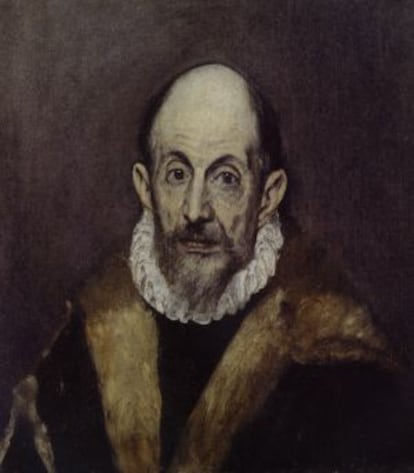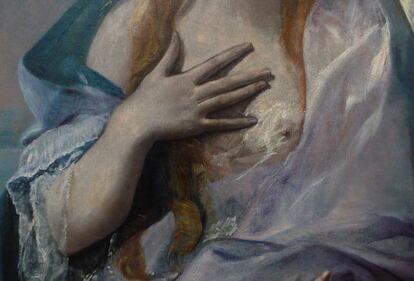Four centuries on from his death, time to meet the real El Greco
A very different picture is emerging of Domenikos Theotokopoulos Rather than being a religious mystic, the Cretan was a proud and worldly artist

Standing in front of the grille separating the choir from the rest of the church, the mother superior of Santo Domingo el Antiguo complains that people are not coming to see her Grecos. "Toledo is very commercialized, and tourists only go and see five things. They don't come here because they don't know about it, because nobody brings them here or because they get lost on the way," says María del Pilar García-Argudo, 73, the head of a group of 11 Cistercian nuns who live in a convent she herself joined in 1962.
Local lore holds that the body of El Greco is buried in a crypt inside this very church. And while it is true that the Renaissance painter was buried in Santo Domingo el Antiguo after his death on April 7, 1614, and that one of his last paintings, The Adoration of the Shepherds (which now hangs at the Prado Museum) was made for this church, history shows that four years later the nuns asked El Greco's son to take the remains away.
It may well be true that Toledo's tour operators do not do justice to this convent, but historians consider it a milestone in the career of the Crete-born artist (El Greco was a nickname meaning The Greek). It was here that he painted one of his first commissioned works upon his arrival in Spain in 1577. Shortly after settling down in the Imperial City, Domenikos Theotokopoulos focused on his work for Santo Domingo el Antiguo, which comprised the main altarpiece and two side altars, for a total of eight pieces. The convent preserves three of those; the rest are copies, whose originals are held by museums in Madrid, Chicago and Saint Petersburg.
The convent thus illustrates much about El Greco's life and career: his ties to Toledo, his lawsuits with his clients and the dissemination of his work.
Meanwhile, inside the sacristy of the cathedral of Toledo, everyone is eagerly awaiting the return of El Greco's masterpiece The Disrobing of Christ, a painting that is imposing even when it is not there, judging by the nearly three-meter-high space left on the wall. Next to it is Goya's The Arrest of Christ and 13 other canvases by El Greco and his assistants.

The cathedral dean, Juan Sánchez, says he would like to reopen the sacristy to the public on January 23, the Day of Saint Ildefonso, patron saint of Toledo. "Isn't it the star of the place?" he asks, in reference to El Greco's painting. The Disrobing of Christ once triggered a much-publicized lawsuit between cathedral governors and the painter. The cathedral council assessed the work at 227 ducats, while El Greco felt it was worth 900. After months of dispute, a bout of jail time tempered the artist's ambitions. "These things happen. I also ask the construction workers in the sacristy for moderation," notes today's dean.
If the Toledo cathedral was a desirable client, there was an even better potential customer that El Greco had his sights on. Construction work on the mammoth project of El Escorial was in full swing, and Philip II asked El Greco to paint The martyrdom of Saint Maurice, an artwork that the monarch paid for generously but which he ultimately sent to a different place from its original destination. El Greco did not like the monumental architecture of El Escorial, and the king did not like El Greco's painting.
Once his relations with two of the major art patrons of the era were tarnished, El Greco sought refuge in portraiture, devotional paintings for private clients and altarpieces -- the great source of income for any artist wishing to work in Spain at the time.
And so he took permanent refuge in Toledo, a town with over 20 parishes, close to 40 convents and a population of 62,000 (compared with today's 82,000). He arrived there at the age of 36 and died there at 73, after fathering a son. Even so, he always remained an outsider who never mastered the Spanish language.
Domenikos Theotokopoulos was born in 1541 in modern-day Heraklion, the capital of Crete, which belonged to the Republic of Venice at the time. There he worked as a painter of icons before moving to "La Serenissima" and from there to Rome to study the Western technique. He spent two years in Rome, time enough to make a personal enemy of the powerful Cardinal Farnese and to familiarize himself with the work of the deceased Michelangelo, whom El Greco amusingly described as "a good man who did not know how to paint."
Year of the Greek
- El Griego de Toledo (The Greek from Toledo). Museo de Santa Cruz. March 14 through June 14. Until now, Toledo had never hosted an exhibition on El Greco. This anthology starts with works made in Crete and Italy and brings together key pieces such as Views of Toledo, on loan from the Metropolitan in New York, Christ on the Cross with two donors, from the Louvre, and The Gentleman with his hand on his breast, from the Prado.
- El Greco and modern painting. Prado Museum (Madrid). June 24 through October 5. Twenty-five works by El Greco and 70 by modern masters - 18 by Picasso - will illustrate the influence of the Cretan on international art beginning in the late 19th century: from Manet to Pollock, not forgetting the Cubists and the Expressionists. Included in the show is Cézanne's version of A Lady in a Fur Wrap.
- El Greco: art and craft. Museo de Santa Cruz (Toledo). September 8 through December 9. A look at the artist's workshop and a universe of replicas, variants and copies.
- Contemporary Toledo. Centro Cultural San Marcos (Toledo). February 18 through June 14. Visions of Toledo through the photography of contemporary artists such as Shirin Neshat, Philip-Lorca di Corcia, Massimo Vitali, José Manuel Ballester or Vik Muniz.
- MUSIC. Concert of the bells by Llorenç Barber, executed from 25 bell towers in Toledo. January 18, day of the launch of the Year of El Greco.
- Requiem Mass by Cristóbal de Morales in memory of the painter. On April 7, the date of El Greco's death, Michael Noone will conduct the Ensemble Plus Ultra inside Toledo cathedral.
- Verdi's Requiem. Riccardo Muti will conduct the Orchestra and Choir of the Teatro Real inside Toledo cathedral on April 12.
- EL GRECO SPACES. Besides the exhibitions of El Greco 2014, it is possible to see around 30 of the artist's works inside the locations that they were originally made for: places such as the sacristy of the cathedral (The Disrobing of Christ), the church of Santo Tomé (The Burial of the Count of Orgaz), the convent of Santo Domingo el Antiguo, the Tavera Hospital (a gem of architecture full of gems of painting) and the chapel of Saint Joseph, which is usually closed to the public but will remain open for as long as the exhibition El Griego de Toledo is on.
It was also in Rome that he met the Castilian noblemen who encouraged him to move to Toledo. Beginning in 1577, the fate of Domenikos Theotokopoulos was forever entwined with that of Spain.
Fernando Marías is the author of the modern work of reference on the Cretan artist: El Greco. Historia de un pintor extravagante (or, El Greco. The story of an extravagant painter). Recently released again in a second, extended edition, the book provides a comprehensive look at a life about which little was known, and about a body of work about which all kinds of things have been said.
Marías, who works as the scientific coordinator of the El Greco 2014 Foundation, created to observe the 400th anniversary of the painter's death, also does an excellent job of pulverizing old clichés about the artist. In his book, Marías paints a portrait of El Greco that has little to do with the stereotypical claims that he was a very religious man who sought solace from the outside world, and who bonded so well with Spanish society that his work became the symbol of the Spanish soul.
"The ongoing problem with El Greco, as far as the collective imagination is concerned, is that he has been described as a hermetic painter about whom very little is known and who was rediscovered around the year 1900. In other words, an artist with an interpretation but no documentation. And that's false."
A century ago, he notes, there were 37 known documents pertaining to El Greco; these days there are over 500, without counting his abundant notes to Vitruvius and Vasari: "Today a very different picture is emerging. A retiring, docile artist, you say? He bombarded his own clients with lawsuits and was impertinent to Philip II himself! He did not turn in his Saint Maurice because he claimed that the canvases were not arriving from Venice... He was just the opposite of a mystic who cares nothing for reality. He was extremely interested in money, always seeking new commercial strategies, always in the red, and always justifying his painting with arguments that had nothing to do with religion. Anyone writing about art at the time mentioned religious painting in every paragraph, yet in the 20,000 words of El Greco's notes there is not one single mention of religion."

As for his supposed "Spanishness," Marías says that "we turned him into a full-blooded Spaniard, but he was playing a different game. He signed his paintings in Greek, and introduced himself as a painter from Greece who was up on the latest trends because he had gotten himself modernized in Italy. He considered himself an extravagant man, different from the rest. That is why his painting had to be different and why it had to be priced differently. He had to charge more because he brought added value to it."
Considering these ambitions, El Greco was primed for a head-on collision with Spanish reality. If Italy held painters in certain intellectual esteem, Spain viewed painting more like the work of craftsmen. This did not marry well with El Greco's exceptionally high idea of himself, his desire for freedom and his thoughts on what it meant to be an artist. He did not adapt easily to the Spanish market, but adapt he did. And the way in which he did so is the backbone of another major El Greco exhibition in Toledo next year: El Greco. Arte y oficio (El Greco, art and craftsmanship). Commissioner Leticia Ruiz, who is the head of Spanish Renaissance painting at the Prado, explains that the show will attempt to explain to viewers the difference between a great Greco, a combined Greco-workshop piece, a pure workshop piece and a copy.
As for El Greco's adaptation to Spain, Leticia Ruiz notes that he became a complete artist -- that is, one who painted but who also designed altarpieces -- which led him to create a workshop with apprentices, woodcarvers, gilders and joiners. This business outfit also introduced into Spain something that was common in Europe: an engraver who helped distribute the paintings on a massive scale. These days it would be called "a new line of business."
The House of El Greco opened in 1911 in Toledo, very near the church of Santo Tomé, which holds the famous Greco painting The Burial of the Count of Orgaz. A century later, in 2011, the same spot became the Museum of El Greco. The new premises seeks to explain the historical context that Theotokopoulos lived in, exhibits 19 of his paintings, and clears up once and for all the confusion regarding the location of the painter's home. Despite the fact that this place used to be called Casa de El Greco, his real house was never here but lower down, near the River Tagus, in the fishermen's quarters.
Just a few meters from the museum, inside a nearby park, there is a monument erected in 1914 to observe the 300th anniversary of the artist's death. This was a key time in the rediscovery of the Renaissance artist through modern eyes. The clearest example of this process is a 1908 monographic study on El Greco by Manuel Bartolomé Cossío, of the progressive education center Institución Libre de Enseñanza.
While this work has been highly praised by experts, Fernando Marías adds some background: "In around 1900 Spain appropriated and modernized El Greco. This isn't written anywhere, but all the Prado Museum catalogues up until 1910 describe El Greco as an Italian painter. That year, as if by magic, they suddenly classified him as part of the Spanish school."
Besides being an excuse for organizing one-off exhibitions, restoring his art and bringing visitors to the convent of Santo Domingo el Antiguo, the Year of El Greco will be very useful indeed if it finally clears up for the average person why El Greco stretched his characters' bodies into unrealistically elongated shapes. Was it mysticism? Did he have eyesight problems? Was he crazy? Or did he use crazy people as models?
Marías falls back on the painter's own notes. "Why elongate the figures? Because they are more beautiful that way," he replies. "The women of Toledo prove this when they wear really high heels. We all want to be longer, and if we can get touched up with Photoshop, all the better."
But how about those twisted bodies that make El Greco's detractors wince? "Since people in paintings do not talk, you have to give them some expression through movement," claims Marías.
The Prado Museum's Leticia Ruiz underscores that elongating figures is typical of the Mannerist style of painting, and not something exclusive to El Greco. Also, the artist did not believe that saints should be represented the same way as mere mortals, even if they have a human shape. Ruiz also notes that every historical period has looked at El Greco with different eyes. And the modern eye was instrumental in his current success: the things that horrified the classicists of the 18th century were the same things that dazzled the 19th-century romantics and their heirs, the avant-garde movements of the 20th century.
It is no coincidence that the Prado dedicated a solo show to El Greco in 1902, and it was just at that time that Pablo Picasso found himself fascinated by El Greco's late work The Opening of the Fifth Seal, which played a key role in the creation of the Málaga artist's early painting Les demoiselles d'Avignon.
Picasso had contemplated this Greco piece at the Paris studio of the painter Ignacio Zuloaga, who had bought it off a physician from Córdoba for 1,000 pesetas (roughly six euros) on a trip to Spain during which he failed to drum up enthusiasm for the Cretan painter.
Next summer, The Opening of the Fifth Seal will be the centerpiece of a Prado exhibition, El Greco and modern painting, exploring the Cretan's influence on artists such as Manet, Kokoschka, Jackson Pollock, Francis Bacon, Cézanne and Picasso.
Javier Barón, head of the 19th-century painting department at the Prado and curator of the upcoming show, explains that "even as Velázquez is the reference for painters who veer toward Naturalism (Courbet, Manet), El Greco is the reference for those who seek a transformation of painting (Cubists, Expressionists, Surrealists)."
But Fernando Marías draws the line when he hears people say that some of El Greco's apostles look like they might have been painted by Francis Bacon. "That is too much. It is true that El Greco was deliberately and truly modern in his own time, but that was in 1600, not 1900. El Greco's work is so varied that everyone sees whatever they want in him. He is a polyhedron that can be grabbed from any side."
Tu suscripción se está usando en otro dispositivo
¿Quieres añadir otro usuario a tu suscripción?
Si continúas leyendo en este dispositivo, no se podrá leer en el otro.
FlechaTu suscripción se está usando en otro dispositivo y solo puedes acceder a EL PAÍS desde un dispositivo a la vez.
Si quieres compartir tu cuenta, cambia tu suscripción a la modalidad Premium, así podrás añadir otro usuario. Cada uno accederá con su propia cuenta de email, lo que os permitirá personalizar vuestra experiencia en EL PAÍS.
¿Tienes una suscripción de empresa? Accede aquí para contratar más cuentas.
En el caso de no saber quién está usando tu cuenta, te recomendamos cambiar tu contraseña aquí.
Si decides continuar compartiendo tu cuenta, este mensaje se mostrará en tu dispositivo y en el de la otra persona que está usando tu cuenta de forma indefinida, afectando a tu experiencia de lectura. Puedes consultar aquí los términos y condiciones de la suscripción digital.
Últimas noticias
Reinhard Genzel, Nobel laureate in physics: ‘One-minute videos will never give you the truth’
Pinochet’s victims grapple with José Antonio Kast’s rise in Chile
How Japan is trying to avert ‘digital defeat’
The complicated life of Francesca Albanese: A rising figure in Italy but barred from every bank by Trump’s sanctions
Most viewed
- Pablo Escobar’s hippos: A serious environmental problem, 40 years on
- Why we lost the habit of sleeping in two segments and how that changed our sense of time
- Charles Dubouloz, mountaineering star, retires at 36 with a farewell tour inspired by Walter Bonatti
- Trump’s obsession with putting his name on everything is unprecedented in the United States
- The Florida Keys tourist paradise is besieged by immigration agents: ‘We’ve never seen anything like this’









































